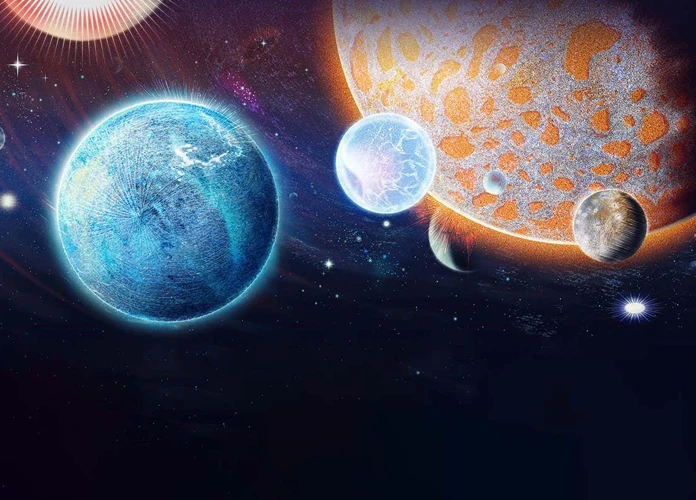Explore the Cosmic Frontier: Hunting for Earth-like Exoplanets in the Habitable Zone
Our universe is vast and full of mysteries, and one of the most intriguing questions is whether there are other habitable worlds beyond our own. The search for exoplanets, planets outside our solar system, has captivated the imagination of scientists and space enthusiasts alike. In this article, we will dive into the fascinating field of exoplanet hunting and take a closer look at the “habitable zone,” that elusive region where Earth-like conditions could potentially exist. Join us on this cosmic journey as we explore the techniques used to detect exoplanets, uncover the characteristics of Earth-like worlds, and discuss the challenges and future missions that aim to unlock the secrets of these distant celestial bodies. Are we alone in the universe? Let’s find out together!
What is an Exoplanet?
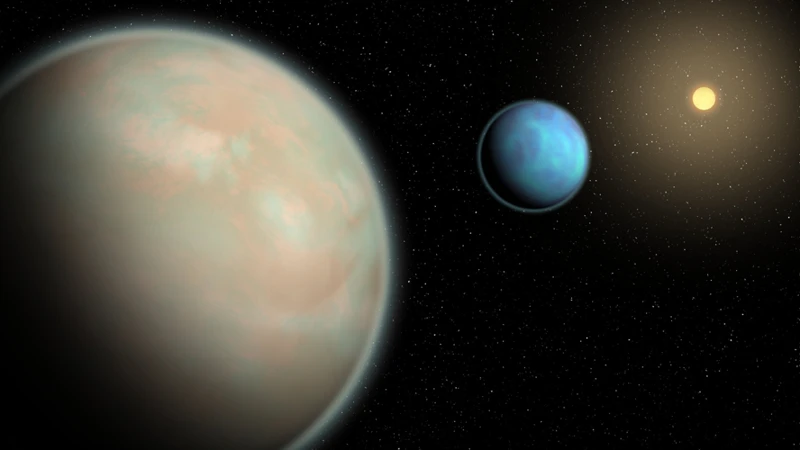
What is an Exoplanet?
An exoplanet, also known as an extrasolar planet, is a planet that orbits a star outside of our solar system. These distant worlds come in a variety of sizes, compositions, and environments, ranging from rocky planets similar to Earth to massive gas giants like Jupiter. The discovery of exoplanets has revolutionized our understanding of the universe and opened up a whole new frontier for exploration. In the past, astronomers could only speculate about the existence of exoplanets, but advancements in technology and observational techniques have made it possible to detect and study these elusive celestial objects. The study of exoplanets has provided insights into planetary formation, the potential for habitable environments, and the distribution of planetary systems throughout the galaxy. By studying exoplanets, scientists hope to unravel the mysteries of the universe and gain a greater understanding of our place in it. To learn more about the methods used to discover exoplanets, check out our article on searching for exoplanets.
The Habitable Zone

The Habitable Zone
The habitable zone, also known as the Goldilocks zone, is the region around a star where conditions are just right for the existence of liquid water on the surface of a planet. This zone is often considered crucial in the search for potential life outside of Earth. Too close to the star, and a planet becomes too hot, causing water to evaporate. Too far from the star, and a planet becomes too cold, leading to a frozen and inhospitable environment. The habitable zone is characterized by a delicate balance between receiving enough energy from the star to maintain a stable climate and not receiving too much heat. When a planet is in this zone, there is the potential for it to have a stable atmosphere and for liquid water to exist, which are two key ingredients for life as we know it. While the habitable zone is a useful concept when assessing the potential habitability of an exoplanet, it’s important to note that other factors, such as the planet’s atmosphere and geology, also play a significant role. To learn more about the role of citizen scientists in exoplanet exploration, check out our article on the importance of citizen scientists in advancing our understanding of the universe.
Defining the Habitable Zone
The habitable zone, also known as the Goldilocks zone, refers to the region around a star where conditions may be just right to support liquid water and potentially life as we know it. This zone is not too hot, where water would boil away, and not too cold, where water would freeze into ice. Instead, it is the orbital distance from a star where the temperature is within a range that allows for the stability of liquid water on the planet’s surface. The size and location of the habitable zone depend on various factors such as the star’s size, temperature, and energy output. Scientists use a combination of theoretical models and observations to estimate the boundaries of these zones for different types of stars. Studying the habitable zone is crucial in the search for potentially habitable exoplanets that could support life as we know it. For more information on the mysteries surrounding exoplanets, check out our article on unveiling the mysteries of hot Jupiter exoplanets.
Importance of the Habitable Zone
Importance of the Habitable Zone
The habitable zone, also known as the “Goldilocks zone,” is a critical concept in the search for exoplanets. This zone refers to the region around a star where conditions are just right for the existence of liquid water on the surface of a planet. Liquid water is widely considered a key ingredient for life as we know it, making the habitable zone a prime target in the quest for potentially habitable exoplanets. Planets too close to their star will have water vaporize into steam, while those too far will have water freeze into ice. Within the habitable zone, however, a planet has the potential to maintain stable liquid water, which is crucial for the development and sustenance of life. It’s important to note that while the habitable zone provides initial criteria for potential habitability, it is not the sole determinant of a planet’s ability to support life. Other factors, such as the planet’s atmosphere, composition, and presence of a stable climate, also play significant roles. Understanding the boundaries and characteristics of the habitable zone allows scientists to prioritize their search for Earth-like exoplanets and focus on regions where conditions may be favorable for the emergence of life. The hunt for exoplanets within the habitable zone is an exciting endeavor that brings us one step closer to unraveling the age-old question of whether we are alone in the universe.
Techniques for Exoplanet Detection
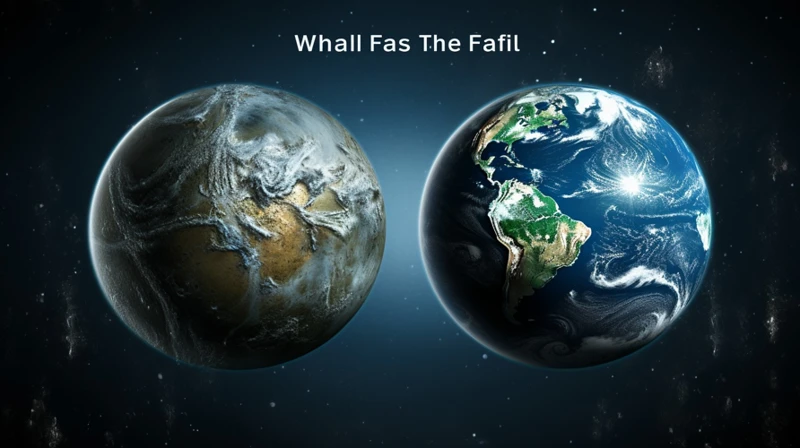
Techniques for Exoplanet Detection
Detecting exoplanets may seem like an astronomical challenge, but scientists have developed several innovative techniques to identify these distant worlds. One such technique is transit photometry, which involves monitoring a star for periodic dimming caused by a planet passing in front of it. By carefully observing these changes in brightness, scientists can infer the presence and characteristics of the exoplanet. Another commonly used method is Doppler spectroscopy, also known as the radial velocity method. This technique relies on detecting the small wobbles in a star’s motion caused by the gravitational pull of an orbiting planet. By measuring the changes in a star’s spectral lines, scientists can determine the presence and properties of the exoplanet. Direct imaging is another powerful technique that allows astronomers to directly capture images of exoplanets. This method is challenging because exoplanets are often much fainter than their host stars and have to be separated from the star’s glare. However, recent advancements in instrument technology have made direct imaging increasingly successful. By employing a combination of these techniques, scientists can detect and characterize a wide range of exoplanets, providing valuable insights into the diversity of planetary systems in our galaxy.
Transit Photometry
Transit Photometry is a powerful technique used to detect exoplanets by measuring the slight decrease in brightness of a star when a planet passes in front of it. When an exoplanet transits, or crosses, in front of its host star as observed from Earth, it causes a temporary dip in the star’s brightness. By continuously monitoring the brightness of a star over time, scientists can identify these periodic dips and infer the presence of an exoplanet. Transit photometry allows astronomers to determine various properties of exoplanets, such as their size, orbital period, and distance from their host star. Additionally, this technique provides valuable insights into the composition and atmosphere of exoplanets. Although transit photometry can be used to detect various types of exoplanets, it is particularly effective in identifying large exoplanets that orbit close to their host star, known as “hot Jupiters.” This technique has played a crucial role in the discovery of thousands of exoplanets and continues to be an essential tool in the search for Earth-like worlds beyond our solar system.
Doppler Spectroscopy
Doppler Spectroscopy, also known as the radial velocity method, is a powerful technique used to detect exoplanets by observing changes in a star’s spectrum caused by the planet’s gravitational influence. This method relies on the principle of the Doppler effect, which states that the wavelength of light emitted by a source is shifted when that source is moving towards or away from an observer.
To measure the radial velocity of a star, astronomers look for subtle changes in the star’s spectral lines as it is influenced by the gravitational tug of an exoplanet. When a star moves towards us, the light is “blueshifted,” causing the spectral lines to shift towards shorter wavelengths. Conversely, when a star moves away from us, the light is “redshifted,” causing the spectral lines to shift towards longer wavelengths.
By carefully analyzing these shifts in the star’s spectrum, astronomers can determine the presence and properties of an orbiting exoplanet. The amount of shift observed provides information about the exoplanet’s mass, orbital period, and inclination. This method is most effective for detecting large exoplanets that are close to their parent stars, as the gravitational influence is stronger, resulting in larger radial velocity variations.
One of the key advantages of Doppler Spectroscopy is its ability to detect exoplanets indirectly, even if they do not pass directly in front of their host star (as in the case of transit photometry). It allows scientists to study exoplanets that may have different orbital orientations, providing a more comprehensive understanding of planetary systems.
Although Doppler Spectroscopy has been successful in identifying hundreds of exoplanets to date, it does have limitations. This method is more suitable for detecting massive exoplanets that are closer to their host stars. Smaller, Earth-sized planets in the habitable zones of their stars are more challenging to detect due to their smaller mass and resulting smaller radial velocity shifts.
To learn more about other techniques used to discover exoplanets, consider reading our article on methods for searching exoplanets.
Direct Imaging
Direct imaging is a powerful technique used in the search for exoplanets, particularly those that are far from their host stars. This method involves directly observing the light emitted or reflected by the exoplanet itself, separate from the light of its star. The process is incredibly challenging due to the vast difference in brightness between the planet and its star.
To overcome this obstacle, astronomers use advanced telescopes equipped with instruments that can block out the overwhelming glare of the star, allowing them to see the much fainter light from the exoplanet. One common technique employed is the use of a coronagraph, which is a device that introduces an artificial eclipse to mask the star’s brightness.
Direct imaging is most successful in detecting massive gas giants that are young and still glowing with heat from their formation, as they emit a significant amount of infrared radiation. These planets are typically large and have wide orbits, making them easier to separate from their host stars.
One notable example of a successful direct imaging mission is the Gemini Planet Imager (GPI). Installed on the Gemini South Telescope in Chile, the GPI uses a combination of adaptive optics and a coronagraph to block out the star’s light and capture images of exoplanets. Through its observations, the GPI has contributed to the discovery of several exoplanets and has provided valuable insights into their atmospheres and compositions.
While direct imaging has its limitations and is currently more suited for detecting large, young gas giants, advancements in technology continue to improve its capabilities. Future missions and instruments, such as the upcoming James Webb Space Telescope (JWST), hold great promise for enhancing direct imaging techniques and expanding our knowledge of exoplanets.
Direct imaging is a challenging yet valuable method for studying exoplanets. By directly observing the light emitted or reflected by these distant worlds, astronomers can gain insights into their characteristics, compositions, and atmospheres. With ongoing advancements in technology, direct imaging will play a crucial role in expanding our understanding of exoplanets and the possibilities for life beyond our solar system.
Characteristics of Earth-like Exoplanets
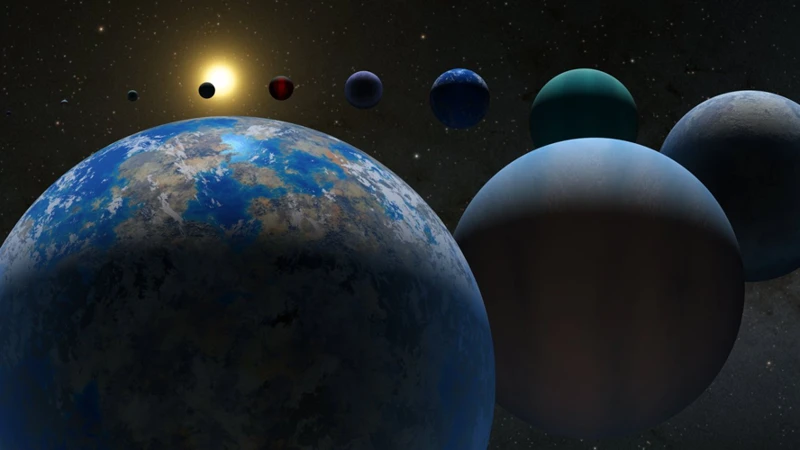
Characteristics of Earth-like Exoplanets
Earth-like exoplanets are celestial bodies that bear striking similarities to our own planet. These exoplanets possess certain characteristics that make them potential candidates for harboring life as we know it. One key similarity is their size and composition. Earth-like exoplanets are often rocky, meaning they have a solid surface rather than being gas giants like Jupiter or Saturn. They also tend to fall within a size range similar to Earth, with diameters ranging from about 0.7 to 1.5 times that of our planet. Another critical factor is the presence of an atmosphere. Earth’s atmosphere plays a vital role in maintaining a stable climate and supporting life. Similarly, an atmosphere on an exoplanet could regulate surface temperatures and provide protection from harmful cosmic radiation. Another important consideration is the availability of water, as it is essential for supporting life as we know it. Earth-like exoplanets within the habitable zone, where liquid water can potentially exist, are of particular interest. Finally, stellar activity is a crucial factor to consider. Stars with high levels of activity, such as frequent and powerful flares, can significantly impact the habitability of nearby exoplanets. Understanding the characteristics of Earth-like exoplanets is vital in our search for potentially habitable worlds and the quest for extraterrestrial life.
Similarities to Earth
Earth-like exoplanets exhibit similarities to our own planet, making them prime candidates in the search for extraterrestrial life. These exoplanets have several key characteristics that resemble Earth, including their size, composition, and location within the habitable zone of their host star. In terms of size, Earth-like exoplanets fall within a range that allows for the presence of a solid surface, where the conditions necessary for life as we know it are more likely to exist. These planets may also have rocky compositions, with elements and compounds that are essential for the formation of life. Additionally, the location of these exoplanets within the habitable zone, often referred to as the “Goldilocks zone,” means that they are at an optimal distance from their star to support the presence of liquid water, a crucial ingredient for life as we understand it. These similarities to Earth make the search for Earth-like exoplanets a priority in the quest to find habitable environments beyond our own planet.
Atmospheric Composition and Water
Understanding the atmospheric composition and presence of water on exoplanets is crucial in the search for Earth-like worlds. Water is an essential ingredient for life as we know it, so the detection of water vapor in an exoplanet’s atmosphere could indicate the possibility of habitability. Scientists use a variety of techniques to study the atmospheres of exoplanets, including transmission spectroscopy and emission spectroscopy. Transmission spectroscopy involves analyzing the change in starlight as it passes through an exoplanet’s atmosphere, revealing the presence of different molecules and their abundances. Emission spectroscopy, on the other hand, analyzes the infrared radiation emitted by the exoplanet itself, providing insights into its atmospheric composition. By studying the presence of gases like oxygen, methane, and carbon dioxide, scientists can infer the potential habitability and the potential presence of biological activity on exoplanets. Additionally, the detection of water vapor in an exoplanet’s atmosphere can provide valuable clues about the planet’s surface conditions and the availability of liquid water, a key requirement for life as we know it. With advancements in observational technology and future missions, such as the James Webb Space Telescope, scientists hope to uncover more about the atmospheric compositions and the presence of water on exoplanets, bringing us closer to answering the fundamental question of whether we are alone in the universe.
Stellar Activity
Stellar Activity
Stellar activity plays a crucial role in determining the habitability of an exoplanet. The activity of a star refers to its magnetic fields, sunspots, flares, and other phenomena that can affect the surrounding planetary system. These stellar activities can have significant impacts on the atmosphere and climate of an orbiting exoplanet.
One key factor to consider is the stellar flares. These sudden and intense bursts of energy can release powerful radiation, which can potentially strip away the atmosphere of an exoplanet. If a star exhibits frequent and intense flaring activity, it may not be conducive to supporting life as we know it.
Another important aspect is the stellar wind. Stars emit streams of charged particles, known as stellar winds, which can interact with the magnetic fields of exoplanets. This interaction can lead to the erosion of the planet’s atmosphere over time, making it less suitable for life.
The age of a star also affects its activity level. Young stars tend to be more active and have higher levels of magnetic activity compared to older, more stable stars. This is important because stellar activity can impact the overall habitability of exoplanets in the system.
Understanding stellar activity is crucial in assessing the potential habitability of exoplanets. Scientists study the activity of stars using various techniques, including spectroscopy and monitoring changes in their brightness over time. By analyzing the behavior of stars, researchers can gain insights into the conditions that may exist on nearby exoplanets. To discover more about the mysteries of exoplanets, check out our article on hot Jupiter exoplanets.
Challenges in Exoplanet Detection

Challenges in Exoplanet Detection
Detecting exoplanets is an incredibly complex task that presents scientists with numerous challenges. One major challenge is the presence of noise and instrumentation. Astronomical observations are susceptible to various sources of interference, such as background radiation and instrumental artifacts, which can distort or mask the signals from exoplanets. Scientists must develop advanced algorithms and data analysis techniques to filter out unwanted signals and separate them from genuine exoplanet signals. Another challenge is the size and distance of exoplanets. Many exoplanets are much smaller than their host stars and are located at vast distances from Earth. These factors make it difficult to detect their presence and obtain detailed information about their properties. Additionally, there is the issue of false positives – instances where a signal appears to indicate the presence of an exoplanet, but it turns out to be caused by something else, such as a stellar phenomenon or instrument malfunction. Distinguishing genuine exoplanet signals from false positives requires diligent scrutiny and confirmation through multiple observation techniques. Despite these challenges, scientists continue to push the boundaries of exoplanet detection, developing new technologies and methods to overcome these obstacles and expand our knowledge of the cosmos.
Noise and Instrumentation
Noise and Instrumentation play a crucial role in the challenges faced during exoplanet detection. Noise refers to any unwanted signals or disturbances that can interfere with the data collected from telescopes and instruments. This noise can arise from various sources, such as cosmic rays, Earth’s atmosphere, and instrumental limitations. To overcome these obstacles, astronomers employ advanced instrumentation designed to minimize noise and enhance the sensitivity of their observations. High-precision instruments like the Kepler and TESS space telescopes are equipped with extremely sensitive detectors and filters to carefully calibrate and analyze the data. Additionally, researchers constantly strive to improve instruments, develop new techniques, and implement innovative algorithms to differentiate between legitimate exoplanet signals and background noise. Ensuring accurate measurements and reducing noise is essential for the accurate identification and characterization of exoplanets, bringing us closer to understanding the existence of Earth-like worlds in distant corners of the universe.
Size and Distance
The quest to find exoplanets is not without its challenges. One of the major obstacles in detecting exoplanets is their size and the vast distances that separate us from them. Exoplanets are typically much smaller than their parent stars, making them incredibly difficult to observe directly. Additionally, the vast distances between stars and their exoplanets further complicate the detection process.
To put things into perspective, consider the fact that our closest neighboring star, Proxima Centauri, is about 4.24 light-years away from Earth. This means that any exoplanets orbiting this star are at a considerable distance from us, making their detection even more challenging. Not only do we need telescopes with exceptional sensitivity to capture the faint signals emitted by these distant worlds, but we also need to account for the effects of stellar glare, which can easily overshadow the presence of an exoplanet.
The size of an exoplanet itself poses a challenge. Since exoplanets are significantly smaller than stars, their signal gets blended with the much brighter light emitted by their host stars. This makes it difficult to separate the light from the planet from the light emitted by the star. To overcome this challenge, scientists have developed sophisticated techniques, such as transit photometry and direct imaging, to indirectly detect and study exoplanets.
In transit photometry, scientists observe changes in a star’s brightness as an exoplanet passes in front of it, causing a slight decrease in the star’s luminosity. By carefully analyzing these changes in brightness, astronomers can deduce the presence and characteristics of an exoplanet.
Direct imaging, on the other hand, involves capturing actual images of exoplanets. This technique is particularly useful for studying large, Jupiter-like exoplanets that orbit far from their host stars. By blocking out the overwhelming light from the star, astronomers can directly image the exoplanet and study its properties.
Despite the complexities involved in detecting exoplanets, scientists continue to push the boundaries of technology and develop innovative techniques to overcome these hurdles. The search for exoplanets has led to remarkable discoveries and continues to fuel our curiosity about the vastness of the universe.
False Positives
False Positives
While the search for exoplanets is an exciting and promising endeavor, it is not without its challenges. One of the major hurdles in exoplanet detection is the presence of false positives. False positives are instances where a signal is initially believed to indicate the presence of an exoplanet, but further analysis reveals a different explanation for the observed data. These can occur due to a variety of factors, such as instrumental noise, stellar activity, or even the presence of a binary star system. False positives can be particularly problematic because they can lead to the misinterpretation of data and the incorrect identification of exoplanets. However, scientists have developed rigorous methods to mitigate false positives through careful analysis, thorough follow-up observations, and the use of statistical techniques. These methods help ensure that the planets identified are indeed real and increase the reliability of exoplanet discoveries. It is through these continuous refinements that the field of exoplanet research progresses, enabling us to distinguish between true exoplanets and false positives and further our understanding of the universe.
The Role of Kepler and TESS

The Role of Kepler and TESS
Two groundbreaking missions have played a crucial role in the discovery and study of exoplanets: Kepler and TESS.
- Kepler Mission: Launched in 2009, the Kepler spacecraft was specifically designed to search for exoplanets using the transit photometry method. By monitoring the brightness of over 150,000 stars in a single patch of the sky, Kepler successfully detected thousands of exoplanet candidates, including many Earth-sized planets within their star’s habitable zone. This mission dramatically expanded our knowledge of exoplanets and led to the confirmation of numerous potentially habitable worlds. Additionally, the Kepler mission provided valuable data for studying planetary systems, planet occurrence rates, and the diversity of exoplanetary compositions.
- Transiting Exoplanet Survey Satellite (TESS): Launched in 2018, TESS is the successor to the Kepler mission. TESS is equipped with an array of specialized cameras that survey the entire sky, dividing it into sectors and observing each sector for a period of time. By monitoring the brightness of over 200,000 pre-selected stars for signs of planet transits, TESS has continued the work of Kepler, discovering numerous exoplanets and expanding our understanding of their characteristics. TESS focuses on nearby stars, making it easier for follow-up observations to study the atmospheres and compositions of these exoplanets.
Both the Kepler and TESS missions have contributed tremendously to the field of exoplanet research, providing invaluable data that has helped scientists uncover the diversity and prevalence of exoplanets in our galaxy. These missions have paved the way for future space-based observatories and ground-based telescopes, propelling us closer to answering the age-old question of whether we are alone in the universe.
Kepler Mission
The Kepler mission, named after the influential astronomer Johannes Kepler, was a space telescope launched by NASA in 2009 with the primary goal of discovering and characterizing exoplanets. This pioneering mission used the transit photometry method to detect exoplanets by measuring the dimming of a star’s light as a planet passes in front of it. Kepler’s precision and longevity allowed it to observe a vast number of stars in a specific region of the sky, known as the Kepler field, and identify thousands of exoplanet candidates. By analyzing the data collected by Kepler, scientists were able to estimate the size, orbital period, and even the potential habitability of these exoplanets. Kepler’s discoveries revolutionized our understanding of the prevalence of exoplanets in the galaxy and provided crucial data for further exploration. Although the mission officially ended in 2018, the legacy of the Kepler mission continues to shape our understanding of the cosmos.
Transiting Exoplanet Survey Satellite (TESS)
The Transiting Exoplanet Survey Satellite, or TESS, is a NASA mission designed to search for exoplanets using the transit photometry method. Launched in 2018, TESS surveys the sky for relatively close and bright stars, observing large sectors of the sky in search of exoplanet transits. TESS detects exoplanets by measuring the slight dips in a star’s brightness that occur when a planet passes in front of it, blocking a small fraction of the star’s light. The satellite is equipped with four wide-field cameras that monitor different parts of the sky, allowing it to survey a large area at once. TESS focuses on finding exoplanets orbiting bright and nearby stars, making them ideal candidates for future observations and detailed characterization. By studying these exoplanets, scientists can gather information about their sizes, masses, and the length of their orbits. TESS has already made significant discoveries, including the identification of several Earth-sized exoplanets and a range of other intriguing planetary systems. Its mission is ongoing, and as it continues to scan the cosmos, TESS will provide valuable data to expand our knowledge of exoplanets and increase the chances of finding potentially habitable worlds.
Future Missions and Instruments
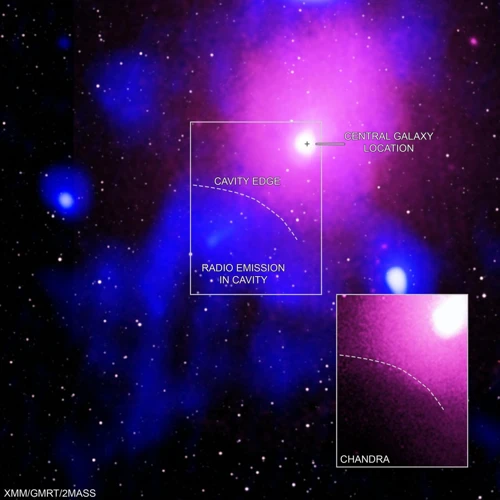
Future Missions and Instruments
The search for exoplanets is far from over, as scientists and astronomers are constantly developing new missions and instruments to delve deeper into the cosmos. Here are some of the exciting future missions and instruments that hold promise in expanding our understanding of exoplanets:
1. James Webb Space Telescope (JWST): Considered the successor to the Hubble Space Telescope, the JWST is set to launch in 2021. This highly anticipated space observatory will have enhanced sensitivity and imaging capabilities, allowing it to study the atmospheres of exoplanets in greater detail. By analyzing the composition of these atmospheres, scientists can determine if there are any signs of habitability or even detect the presence of certain chemicals that could indicate the existence of life.
2. PLATO Mission: The PLATO (Planetary Transits and Oscillations of stars) mission, scheduled for launch in 2026, aims to detect and characterize exoplanets using the transit method. With an array of telescopes onboard, PLATO will survey a large portion of the sky to identify and study exoplanets, with a focus on rocky planets within the habitable zone. This mission will provide valuable data for understanding the frequency and variety of exoplanets and could potentially discover Earth-like worlds.
3. Habitable Exoplanet Observatory (HabEx): Currently under study by NASA, HabEx is a concept for a future space-based observatory dedicated to the search for habitable exoplanets. It would be equipped with a large mirror and advanced imaging technology, allowing for detailed observations of exoplanets and their atmospheres. HabEx aims to answer fundamental questions about the potential for life beyond Earth and further our understanding of planetary systems throughout the universe.
These future missions and instruments represent the next phase in exoplanet exploration, bringing us closer to answering age-old questions about the existence of extraterrestrial life and expanding our knowledge of the vast cosmic landscape. As technology continues to advance, we can look forward to even more groundbreaking discoveries that will reshape our understanding of the universe we call home.
James Webb Space Telescope (JWST)
The is an upcoming space telescope designed to revolutionize our understanding of the universe. Set to launch in 2021, the JWST is a joint collaboration between NASA, the European Space Agency (ESA), and the Canadian Space Agency (CSA). This ambitious observatory is hailed as the successor to the Hubble Space Telescope and is equipped with advanced technology that will allow it to peer deeper into space and capture more detailed images than ever before. The JWST will have a large primary mirror, measuring about 6.5 meters in diameter, which will collect and focus light from distant celestial objects. This telescope will operate primarily in the infrared range, which is ideal for studying the earliest stars and galaxies in the universe and for the detection of exoplanets. Its advanced instruments will enable scientists to analyze the compositions of exoplanet atmospheres in search of potential signs of life. The JWST will open up new frontiers in astrophysics and exoplanet research, allowing us to expand our knowledge of the cosmos and potentially answer some of the most profound questions about our existence.
PLATO Mission
PLATO Mission
The PLATO (Planetary Transits and Oscillations of Stars) mission is a space-based observatory designed to detect and characterize exoplanets. It is an ambitious project led by the European Space Agency (ESA) and is scheduled to launch in the mid-2020s. PLATO aims to build upon the successes of previous missions, such as Kepler and TESS, by expanding the search for exoplanets into new territories. The mission’s primary objective is to identify and study terrestrial planets, especially those located within the habitable zone of their host stars. PLATO will search for exoplanets using the transit method, which involves measuring the slight dimming of a star’s light as a planet passes in front of it. By monitoring the brightness of a large number of stars simultaneously, PLATO will be able to detect a wide range of planets, from Earth-sized rocky worlds to gas giants in close orbit. Additionally, PLATO will study the asteroseismology of stars, allowing scientists to determine the properties of the host stars and refine the measurements of the exoplanets. With its advanced instrumentation and extended mission duration, PLATO is expected to discover thousands of new exoplanets and revolutionize our understanding of planetary systems in our galaxy. The mission will contribute significantly to the ongoing search for Earth-like worlds and further our quest to find potential habitats for life beyond our solar system.
Habitable Exoplanet Observatory (HabEx)
Habitable Exoplanet Observatory (HabEx)
The Habitable Exoplanet Observatory, or HabEx, is an upcoming NASA mission designed to search for and study habitable exoplanets. Its primary goal is to characterize the atmospheres of these alien planets and determine if they have the potential to support life as we know it. HabEx will utilize a next-generation space telescope equipped with advanced imaging technology capable of capturing detailed images of exoplanets. By observing the light that passes through the atmospheres of these distant worlds, scientists will be able to analyze the chemical composition and search for key biomarkers such as water vapor, oxygen, and methane. HabEx will also investigate the formation and evolution of planetary systems and deliver valuable data on the history and habitability of exoplanets. With its advanced capabilities, HabEx aims to not only detect potentially habitable exoplanets but also provide crucial insights into the environments and conditions necessary for life to thrive. Stay tuned for more updates on the Habitable Exoplanet Observatory as the mission progresses.
The Search for Life
The Search for Life
One of the most captivating aspects of exoplanet exploration is the search for life beyond our own planet. Scientists are driven by the age-old question: are we alone in the universe? While detecting life on exoplanets is an incredibly complex endeavor, researchers are developing new methods and technologies to hunt for potential signs of life. One approach is to analyze the biological signatures in the atmospheres of exoplanets. Earth’s atmosphere contains various gases, such as oxygen and methane, that are produced by living organisms. By studying the chemical composition of exoplanet atmospheres, scientists hope to identify similar gases that could indicate the presence of life. Another avenue of exploration involves the development of technological advances that enable the direct detection of life. This includes the search for technosignatures, which are traces of advanced technology produced by extraterrestrial civilizations. It is an exciting and challenging mission to search for life beyond Earth, but with each new discovery, our understanding of the potential for life in the universe expands. The possibilities are endless, and the search continues to push the boundaries of our knowledge.
Biological Signatures in Exoplanet Atmospheres
The quest for life beyond Earth is fueled by the search for biological signatures in the atmospheres of exoplanets. These signatures can provide tantalizing clues about the possibility of life existing elsewhere in the universe. One key indicator is the presence of certain gases, such as oxygen (O2) and methane (CH4), which on Earth are produced by living organisms. The detection of such gases in the atmosphere of an exoplanet could suggest the presence of life. However, it is important to consider alternative explanations as well, as these gases can also arise from non-biological processes. Scientists are developing sophisticated instruments, such as high-resolution spectrographs, to analyze the composition of exoplanet atmospheres and search for these telltale signs of life. By studying the atmospheric chemistry of exoplanets, researchers hope to unlock the secrets of alien life and gain a deeper understanding of our place in the universe.
Technological Advances for Life Detection
Technological Advances for Life Detection
The search for life beyond Earth is one of the most compelling quests in modern science. As our knowledge of exoplanets grows, researchers are developing advanced technologies to detect signs of life in the atmospheres of these distant worlds. One such technology is the James Webb Space Telescope (JWST), set to launch in 2021. The JWST will be equipped with an instrument called the Near Infrared Spectrograph (NIRSpec), which will enable scientists to analyze the composition of exoplanet atmospheres. By detecting the presence of key molecules such as water, carbon dioxide, and oxygen, researchers can assess the potential habitability of these planets. Another exciting development in the field of life detection is the use of Laser Absorption Spectroscopy. This technique involves firing laser beams at exoplanet atmospheres and analyzing the resulting light absorption patterns to determine the presence of specific molecules associated with life. The Characterizing Exoplanet Satellite (CHEOPS) mission, scheduled to launch in 2019, will employ this technique to study exoplanet atmospheres and search for signs of life. The upcoming LUVOIR (Large Ultraviolet, Optical, and Infrared Surveyor) and Habitable Exoplanet Imaging Mission (HabEx) missions aim to directly image exoplanets and study their atmospheres, potentially enabling us to detect signs of life through the observation of biologically significant molecules. With each technological leap forward, we come closer to answering the age-old question: are we alone in the universe?
Conclusion
Conclusion
In our quest to explore the cosmos and search for Earth-like exoplanets in the habitable zone, we have witnessed remarkable advancements in our understanding of the universe. The discovery of exoplanets has not only expanded our knowledge of planetary systems but has also ignited our curiosity about the existence of other lifeforms beyond Earth. Through techniques such as transit photometry, Doppler spectroscopy, and direct imaging, scientists have been able to detect and study exoplanets with increasing precision. Missions like Kepler and TESS have played a vital role in cataloging thousands of exoplanets, while future missions such as the James Webb Space Telescope (JWST), PLATO, and Habitable Exoplanet Observatory (HabEx) promise to unlock even more secrets about our cosmic neighbors. The search for life on exoplanets continues to be a tantalizing endeavor. By analyzing the atmospheric composition and searching for biological signatures, scientists strive to uncover the potential for habitable environments and signs of extraterrestrial life. The future of exoplanet exploration is promising, and as technology advances, we are poised to make groundbreaking discoveries in the coming years. So let us keep our gaze fixed on the stars and continue the fascinating journey to uncover the mysteries of the universe.
Frequently Asked Questions
1. How many exoplanets have been discovered so far?
As of now, scientists have discovered over 4,000 confirmed exoplanets, and the number continues to rise as new technologies and observatories come into play.
2. Is there a possibility of finding Earth-like exoplanets?
Absolutely! In fact, researchers have already identified several exoplanets that have similarities to Earth in terms of size, composition, and distance from their host stars.
3. What is the closest exoplanet to Earth?
The closest known exoplanet to Earth is Proxima b, which orbits Proxima Centauri, the closest star to our solar system. It is located approximately 4.24 light-years away.
4. How do scientists determine if an exoplanet is in the habitable zone?
Scientists determine if an exoplanet is in the habitable zone by analyzing its distance from its host star and the amount of radiation it receives. They also consider factors like the planet’s atmosphere and potential for liquid water.
5. Can we gather any information about the atmospheric composition of exoplanets?
Yes, scientists can gather information about the atmospheric composition of exoplanets through a technique called spectroscopy. By analyzing the light passing through or reflecting off the planet’s atmosphere, they can detect the presence of different gases.
6. Can exoplanets have moons?
Yes, exoplanets can have moons just like the planets in our own solar system. These exomoons could potentially have their own unique characteristics and could play a role in the overall habitability of the exoplanet.
7. Are there any missions specifically designed to search for exoplanets?
Yes, there are several missions designed to search for exoplanets. Examples include the Kepler mission, which has discovered thousands of exoplanets, and the Transiting Exoplanet Survey Satellite (TESS), which is conducting an all-sky survey to find new exoplanets.
8. Can citizen scientists contribute to exoplanet exploration?
Absolutely! Citizen scientists can contribute to exoplanet exploration by participating in projects like Planet Hunters, where they help analyze data and identify potential exoplanetary systems. Their contributions are invaluable in the search for new discoveries.
9. Are there any exoplanets that could potentially support life?
While we have not yet found definitive evidence of extraterrestrial life, there are exoplanets within the habitable zone that have the potential to support life as we know it. These Earth-like exoplanets possess the right conditions for liquid water to exist on their surfaces.
10. Will future missions help us further explore exoplanets?
Yes, future missions like the James Webb Space Telescope (JWST), the PLATO mission, and the Habitable Exoplanet Observatory (HabEx) will allow scientists to study exoplanets in even greater detail, providing valuable insights into their atmospheres, compositions, and potential for habitability.

